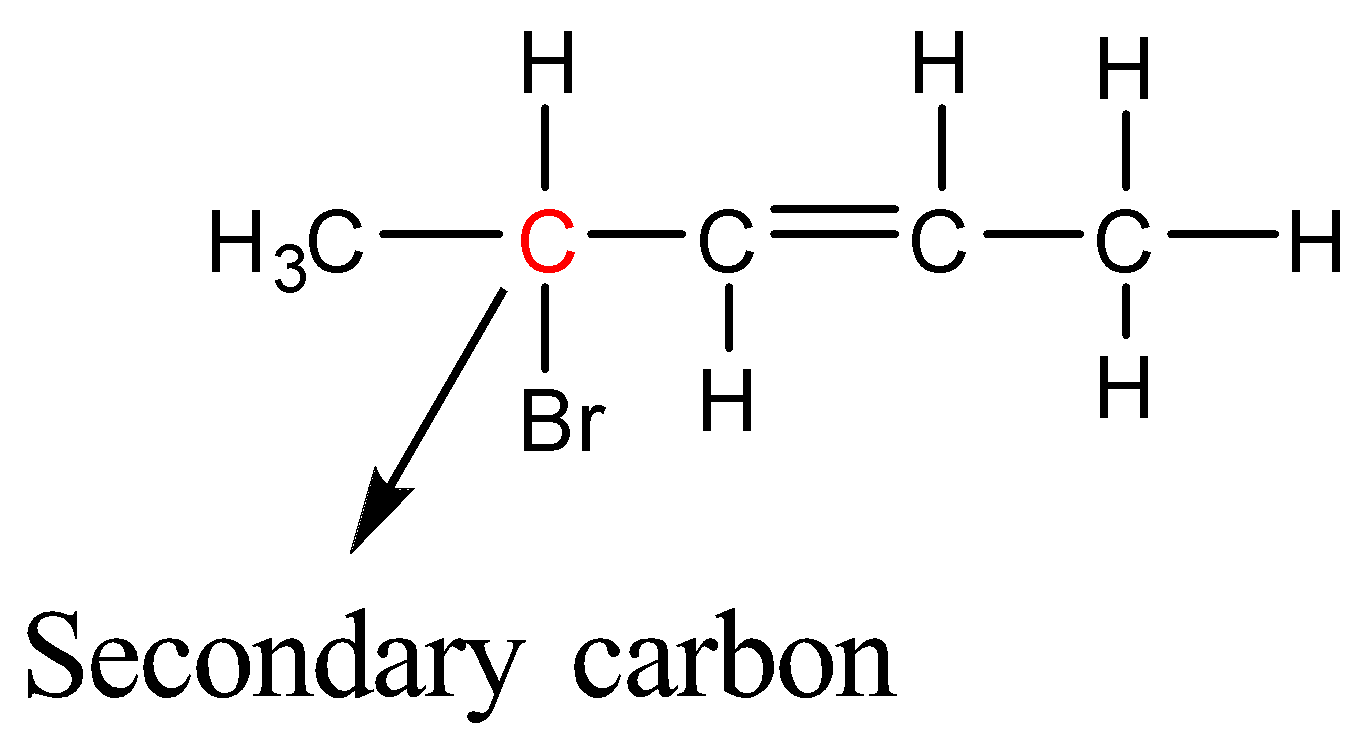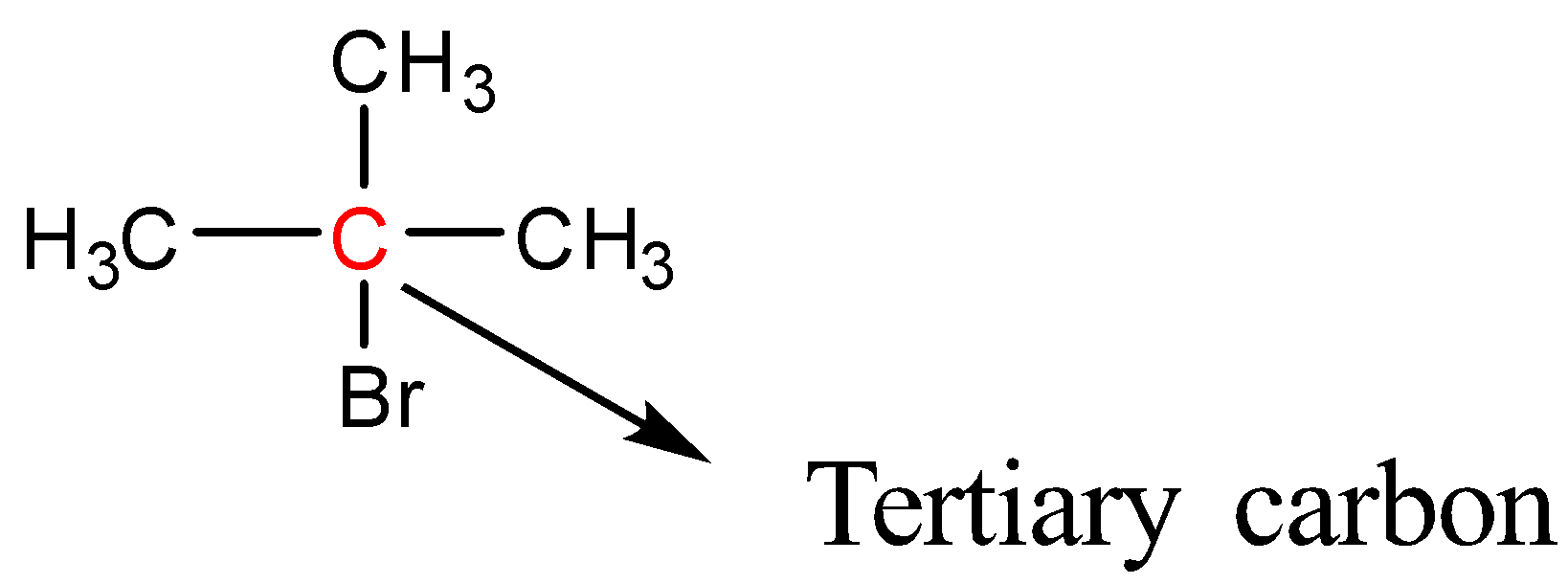
Answer
456.9k+ views
Hint: In primary halides, the halogen atom is bonded to a primary carbon atom. In secondary halides, the halogen atom is bonded to a secondary carbon atom while in tertiary halide; the halogen atom is bonded to a tertiary carbon atom.
Complete step by step answer:
In order to solve this question, we need to first understand the meaning of primary, secondary and tertiary halides.
Primary Halides: In primary halides, the carbon atom bonded to the halogen atom is bonded to only one carbon atom and the rest are hydrogen atoms or the carbon bonded to the halogen atom is only bonded to hydrogen atoms. More simply, we can say that the halogen atom is bonded to a primary carbon.
Example:

Secondary Halides: In secondary halides, the carbon atom bonded to the halogen atom is bonded to two carbon atoms and one hydrogen atom. More simply, we can say that the halogen atom is bonded to a secondary carbon.
Example:

Tertiary halides: In tertiary halides, the carbon atom bonded to the halogen atom is bonded to three carbon atoms. More simply we can say that the halogen atom is bonded to a tertiary carbon.
Example:

In order to solve this question, we need to draw the structures of the compounds given:
1-Bromobut-2-ene

Here Bromine is bonded to a primary carbon atom; therefore 1-Bromobut-2-ene is a primary halide.
4-Bromopent-2-ene

Here Bromine is bonded to a secondary carbon atom; therefore 4-Bromopent-2-ene is a secondary halide.
2-Bromo-2-methylpropane

Here Bromine is bonded to a tertiary carbon atom; therefore 2-Bromo-2-methylpropane is a tertiary halide. So, the correct answer is “Option D”.
Note: In this question all the names of the organic compound were given in accordance with the IUPAC (International Union of Pure and Applied Chemistry) nomenclature. Therefore in order to draw the structure of the compounds from their names, you should know the rules of the IUPAC nomenclature.
Complete step by step answer:
In order to solve this question, we need to first understand the meaning of primary, secondary and tertiary halides.
Primary Halides: In primary halides, the carbon atom bonded to the halogen atom is bonded to only one carbon atom and the rest are hydrogen atoms or the carbon bonded to the halogen atom is only bonded to hydrogen atoms. More simply, we can say that the halogen atom is bonded to a primary carbon.
Example:

Secondary Halides: In secondary halides, the carbon atom bonded to the halogen atom is bonded to two carbon atoms and one hydrogen atom. More simply, we can say that the halogen atom is bonded to a secondary carbon.
Example:

Tertiary halides: In tertiary halides, the carbon atom bonded to the halogen atom is bonded to three carbon atoms. More simply we can say that the halogen atom is bonded to a tertiary carbon.
Example:

In order to solve this question, we need to draw the structures of the compounds given:
1-Bromobut-2-ene

Here Bromine is bonded to a primary carbon atom; therefore 1-Bromobut-2-ene is a primary halide.
4-Bromopent-2-ene

Here Bromine is bonded to a secondary carbon atom; therefore 4-Bromopent-2-ene is a secondary halide.
2-Bromo-2-methylpropane

Here Bromine is bonded to a tertiary carbon atom; therefore 2-Bromo-2-methylpropane is a tertiary halide. So, the correct answer is “Option D”.
Note: In this question all the names of the organic compound were given in accordance with the IUPAC (International Union of Pure and Applied Chemistry) nomenclature. Therefore in order to draw the structure of the compounds from their names, you should know the rules of the IUPAC nomenclature.
Recently Updated Pages
Who among the following was the religious guru of class 7 social science CBSE

what is the correct chronological order of the following class 10 social science CBSE

Which of the following was not the actual cause for class 10 social science CBSE

Which of the following statements is not correct A class 10 social science CBSE

Which of the following leaders was not present in the class 10 social science CBSE

Garampani Sanctuary is located at A Diphu Assam B Gangtok class 10 social science CBSE

Trending doubts
A rainbow has circular shape because A The earth is class 11 physics CBSE

Which are the Top 10 Largest Countries of the World?

Fill the blanks with the suitable prepositions 1 The class 9 english CBSE

How do you graph the function fx 4x class 9 maths CBSE

What is BLO What is the full form of BLO class 8 social science CBSE

The Equation xxx + 2 is Satisfied when x is Equal to Class 10 Maths

Give 10 examples for herbs , shrubs , climbers , creepers

Difference between Prokaryotic cell and Eukaryotic class 11 biology CBSE

Change the following sentences into negative and interrogative class 10 english CBSE




